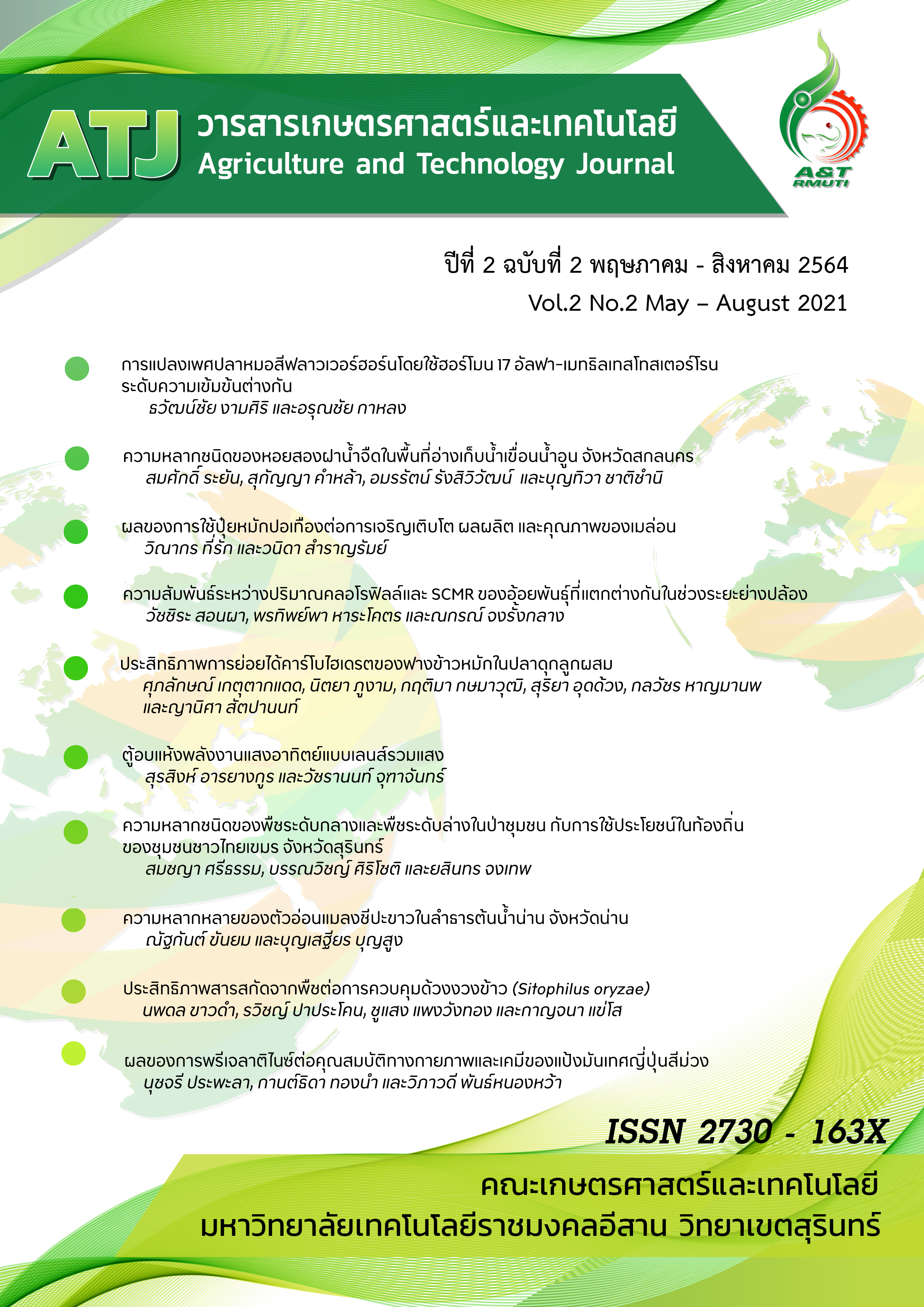ผลของการพรีเจลาติไนซ์ต่อคุณสมบัติทางกายภาพและเคมีของแป้งมันเทศญี่ปุ่นสีม่วง
การดัดแปรแป้งมันเทศญี่ปุ่นสีม่วงด้วยวิธีพรีเจลาติไนซ์ต่อการเปลี่ยนแปลงคุณสมบัติด้านกายภาพและเคมี
คำสำคัญ:
แป้งมันเทศญี่ปุ่น, คุณสมบัติการเกิดเจล, ฤทธิ์การต้านอนุมูลอิสระ, การพรีเจลาติไนซ์บทคัดย่อ
การศึกษาผลของการพรีเจลาติไนซ์ที่อุณหภูมิ 75 และ 85 องศาเซลเซียส เป็นเวลา 5 ชั่วโมง ต่อการเปลี่ยนแปลงคุณลักษณะด้านกายภาพและทางด้านเคมีของแป้งมันเทศญี่ปุ่นสีม่วง พบว่า แป้ง M1-85 ที่ทำการโม่เปียกและมีการให้ความร้อนที่อุณหภูมิ 85 องศาเซลเซียส มีกำลังการพองตัว และการละลายสูงสุด (p<0.05) คุณสมบัติในการเกิดเจลของแป้งที่ทำการวิเคราะห์ด้วยเครื่อง Brabender filanograph พบว่า แป้งโม่แห้งที่พรีเจลาติไนซ์ 75 (M-75) และ M1-85 มีค่าความหนืด ค่า Setback (ค่าการคืนตัวของแป้ง) และค่าเบรกดาวน์ต่ำที่สุด จากผลการทดลองแสดงให้เห็นว่าการทำแป้งพรีเจลาติไนซ์ที่ M2-75 และ M2-85 ของแป้งมันเทศสีม่วงเหมาะสำหรับนำไปใช้เป็นสารให้ความคงตัวในผลิตภัณฑ์อาหาร เช่น อาหารแช่เย็นหรืออาหารแช่แข็ง อย่างไรก็ตาม แป้งที่ทำการพรีเจลาติไนซ์ที่ M3-85 (แป้งโม่ผสมที่พรีเจลาติไนซ์ที่
85 องศาเซลเซียส) เหมาะในการใช้เป็นแป้งสำหรับอาหารเพื่อสุขภาพ เพราะมีสารแอนโทไซยานินสูงสุด มีสารประกอบฟีนอลิก และฤทธิ์การต้านอนุมูลอิสระด้วยวิธี DPPH radical scavenging activity และวิธี ABTS radical scavenging สูง
เอกสารอ้างอิง
กล้าณรงค์ ศรีรอด และเกื้อกูล ปิยะจอมขวัญ. (2550). เทคโนโลยีของแป้ง. พิมพ์ครั้งที่ 2 สำนักพิมพ์มหาวิทยาลัยเกษตรศาสตร์: กรุงเทพฯ.
จิรนาถ บุญคง. (2555). การศึกษาสมบัติทางเคมี–กายภาพของสตารซ์ฟอสเฟตจากเม็ดขนุน. วารสารเทคโนโลยีการอาหารมหาวิทยาลัยสยาม. 7(1): 40-50.
วิจิตรา เหลียวตระกูล และวชิรญา เหลียวตระกูล. (2563). ผลของวิธีการดัดแปรแป้งด้วยกรดและพรีเจลาติไนเซชันต่อสมบัติทางเคมีกายภาพของแป้งกระจับ. วารสารเทคโนโลยีการอาหาร มหาวิทยาลัยสยาม. 15(2): 251-264.
วรนุช ศรีเจษฎารักข์. (2555). เทคโนโลยีคาร์โบไฮเดรต. รายงานการวิจัย. ภาควิชาเทคโนโลยีอาหาร คณะเทคโนโลยี มหาวิทยาลัยขอนแก่น ขอนแก่น.
ศันสนีย์ อุดมระติ และพัชรี ตั้งตระกูล. (2561). ผลของวิธีการโม่ต่อสมบัติทางเคมีฟิสิกส์ของแป้งข้าวขาวดอกมะลิ 105 และการนำไปประยุกต์ใช้ในผลิตภัณฑ์ปลอดกลูเตน. วารสารมหาวิทยาลัยเกษตรศาสตร์ วิทยาเขตบางเขน. 27(2): 312-325.
AOAC. (2005). Official methods of analysis of association of AOAC. 17th. Association of official analytical chemists. USA.
Cornick K.M., Panozzo J.F., and Hong S.H. (1991). A sweeling power test for selecting potential noodle quality wheats. Journal of Agricultural Research. 42(3): 317-323.
Curayag Q.A.L., Dizon E.I. and Hurtada W.A. (2019). Antioxidant activity, chemical and nutritional properties of raw and processed purple-fleshed sweet potato (Ipomoea batatas Lam.) cogent. Food and Agriculture. 5: 1662-1670.
Dasgupta N., and De B. (2007). Antioxidant activity of some leaf vegetable of India: A comparative study. Food Chemistry. 101(2): 471-474.
Gryszkin A., Zieba T., Kapelko-Zeberska M. and Atraszkiewicz A. (2016). Hydrothermal modification of wheat starch part 1 effect of particle size on the viscosity of formed pastes. Journal of Cereal Science. 68: 46-52.
Jubril I., Muazu J. and Mohammed G.T. (2012). Effects of phosphate modified and pregelatinized sweet potato starches on disintegrant property of paracetamol tablet formulations. Journal of Applied Pharmaceutical Science. 2(2): 32-36.
Li C., Chun-Quan L., Da-Jing, L. and Jiang-feng S. (2011). Effect of processing on taste quality and health-relevant functionality of sweet potato tips. Agricultural Sciences in China. 10(3): 456-462.
Liao L., Liu H., Gan Z. and Wu W. (2019). Structural properties of sweet potato starch and its vermicelli quality as affected by heat-moisture treatment. International Journal of Food Properties. 22(1): 1122-1133.
Majzoobi M., Radi M., Farahnaky A., Jamalian J., Tongdang T., and Mesbahi G.H. (2011). Physicochemical properties of pre-gelatinized wheat starch produced by a twin drum drier. Journal of Agricultural Science and Technology. 13: 193-202.
Montilla C.V., Hillebrand S., Butschbach D., Baldermann S., Watannbe N. and Winterhalter P. (2010). Prearative isolation of anthocyanins from Japanese purple sweet potato. (Ipomoea batalas L.) varieties by hight-speed unnter current chromatography. Journal of Agricultural and Food Chemistry. 58: 9899-9904.
Włodarczyk-Stasiak M., Mazurek A., Jamroz J., Pikus S., and Kowalski R. (2019). Physicochemical properties and structure of hydrothermally modified Starches. Food Hydrocolloids. 95(43): 88–97.
Shahidi F. and Ambigaipalan P. (2015). Phenolics and polyphenolics in foods, beverages and spices: Antioxidant activity and health effects: A review. Journal of Functional Foods. 18: 820–897.
Tang Y. and Xu W.C. (2006). Profiles of phenolics, carotenoids and antioxidative capacities of thermal processed white yellow orange and purple sweet potatoes grown in Guilin China. Food Science and Human Wellness. 4(2): 123-132.
Thaipong K., Boonprakob U., Crosby K., Cisneros-Zevallos L. and Hawkins D. (2006). Comparison of DPPH, FRAP, and ORAC assays for estimating antioxidant activity from guava fruit extracts. Journal of Food Composition and Analysis. 19(7): 669-675.
Ulfa G.M., Putri W.D.R., Fibrianto K. and Widjanarko S.B. (2021). Optimization studies on pre-gelatinized sweet potato starch influenced by temperature and time. Food Research. 5(2): 25–30.
Wicaksono L.A., Yunianta Y. and Widyaningsih T.D. (2016). Anthocyanin extraction from purple sweet potato cultivar antin-3 (Ipomoea batalas L.) using maceratation, microwave assisted extraction, ultrasonic assisted extraction and their application as anti-hyperglycemic agents in Alloxan-induced Wistar Rat. International Journal of Pharm Tech Research. 9(3): 181-192.
Wiriyawattana P., Suwonsichon S., Suwonsichon T. (2018). Effects of drum drying on physical and antioxidant properties of riceberry flour. Agriculture and Natural Resources. 52(5): 445-450.
Wlodarczyk S.M., Mazureka A. and Jamroza J. (2019). Physicochemical properties and structure of hydrothermally modified starches. Food Science and Biotechnology. 95: 88–97.
Xu J., Su X., Lim S., Griffin J., Carey E., Katz B., Tomich J., Smith J.S. and Wang W. (2015). Characterisation and stability of anthocyanins in purple-fleshed sweet potato P40. Food Chemistry. 186: 90-96.
Yadav B.S., Guleria P. and Yadav R.B. (2013). Hydrothermal modification of Indian water chestnut starch: Influence of heat-moisture treatment and annealing on the physiochemical, gelatinization and pasting characteristics. LWT-Food Science and Technology. 53: 211-217.
Ye F., Li J. and Zhao G. (2020). Physicochemical properties of different-sized fractions of sweet potato starch and their contributions to the quality of sweet potato starch. Food Hydrocolloids. 108: 1060-1069.
ดาวน์โหลด
เผยแพร่แล้ว
เวอร์ชัน
- 15-02-2024 (2)
- 30-08-2021 (1)
รูปแบบการอ้างอิง
ฉบับ
ประเภทบทความ
สัญญาอนุญาต
ลิขสิทธิ์ (c) 2021 วารสารเกษตรศาสตร์และเทคโนโลยี

อนุญาตภายใต้เงื่อนไข Creative Commons Attribution-NonCommercial-NoDerivatives 4.0 International License.
เนื้อหาและข้อมูลในบทความที่ลงตีพิมพ์ในวารสารทดสอบระบบ ThaiJo2 ถือเป็นข้อคิดเห็นและความรับผิดชอบของผู้เขียนบทความโดยตรงซึ่งกองบรรณาธิการวารสาร ไม่จำเป็นต้องเห็นด้วย หรือร่วมรับผิดชอบใดๆ
บทความ ข้อมูล เนื่อหา รูปภาพ ฯลฯ ที่ได้รับการดีพิมพ์ในวารสารทดสอบระบบ ThaiJo2 ถือเป็นลิขสิทธิ์ของวารสารทดสอบระบบ ThaiJo2 หากบุคคลหรือหน่วยงานใดต้องการนำทั้งหมดหรือส่วนหนึ่งส่วนใดไปเผยแพร่หรือเพื่อกระทำการใดๆ จะต้องได้รับอนุญาตเป็นลายลักอักษรณ์จากวารสารทดสอบระบบ ThaiJo2 ก่อนเท่านั้น







